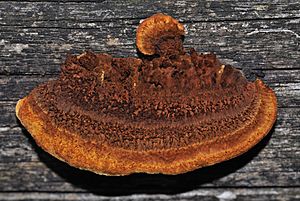Rusty gilled polypore facts for kids
Quick facts for kids Rusty gilled polypore |
|
|---|---|
 |
|
| Scientific classification | |
| Genus: |
Gloeophyllum
|
| Species: |
sepiarium
|
| Synonyms | |
|
Agaricus asserculorum Batsch, (1783) |
|
Gloeophyllum sepiarium, also known as the rusty gilled polypore, is a type of fungus that causes wood to rot. It creates a special kind of damage called brown rot. This fungus grows on dead conifer trees, like pines and firs. You can often find it on wood in places where lumber is stored.
The fungus grows in thin, dark brown or green shapes that look like shelves or brackets. These brackets only grow for one year. They release tiny reproductive cells called spores in the late summer and autumn. Unlike many other polypore fungi, Gloeophyllum sepiarium has gills on its underside. This makes it easy to tell apart. This fungus is not safe to eat.
What Does It Look Like?
The top part of the fungus, called the cap, can be from 2 to 15 centimeters wide. It often looks like a loose fan. When it's growing, the cap is brown with a yellow-orange edge. It feels velvety at first, then becomes smooth. The texture is leathery. It has a mild smell and taste.
The spores of the rusty gilled polypore are white. They are shaped like small cylinders and have a smooth surface.
Similar Fungi You Might See
There are other fungi that look a bit like Gloeophyllum sepiarium. These include Daedalea quercina, Lenzites betulina, and Trametes versicolor.
Learn More
 In Spanish: Gloeophyllum sepiarium para niños
In Spanish: Gloeophyllum sepiarium para niños

